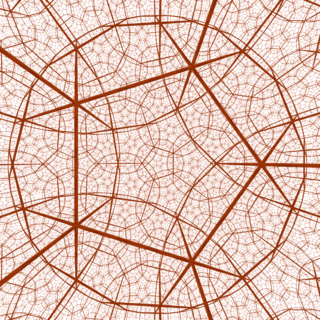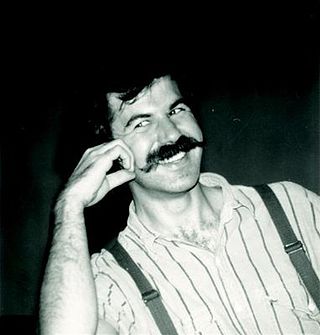Related Research Articles
In mathematics, Thurston's geometrization conjecture states that each of certain three-dimensional topological spaces has a unique geometric structure that can be associated with it. It is an analogue of the uniformization theorem for two-dimensional surfaces, which states that every simply connected Riemann surface can be given one of three geometries . In three dimensions, it is not always possible to assign a single geometry to a whole topological space. Instead, the geometrization conjecture states that every closed 3-manifold can be decomposed in a canonical way into pieces that each have one of eight types of geometric structure. The conjecture was proposed by William Thurston (1982), and implies several other conjectures, such as the Poincaré conjecture and Thurston's elliptization conjecture.

In mathematics, low-dimensional topology is the branch of topology that studies manifolds, or more generally topological spaces, of four or fewer dimensions. Representative topics are the structure theory of 3-manifolds and 4-manifolds, knot theory, and braid groups. This can be regarded as a part of geometric topology. It may also be used to refer to the study of topological spaces of dimension 1, though this is more typically considered part of continuum theory.

In mathematics, a 3-manifold is a topological space that locally looks like a three-dimensional Euclidean space. A 3-manifold can be thought of as a possible shape of the universe. Just as a sphere looks like a plane to a small enough observer, all 3-manifolds look like our universe does to a small enough observer. This is made more precise in the definition below.
In mathematics, more precisely in topology and differential geometry, a hyperbolic 3-manifold is a manifold of dimension 3 equipped with a hyperbolic metric, that is a Riemannian metric which has all its sectional curvatures equal to −1. It is generally required that this metric be also complete: in this case the manifold can be realised as a quotient of the 3-dimensional hyperbolic space by a discrete group of isometries.

In mathematics, a Kleinian group is a discrete subgroup of the group of orientation-preserving isometries of hyperbolic 3-space H3. The latter, identifiable with PSL(2, C), is the quotient group of the 2 by 2 complex matrices of determinant 1 by their center, which consists of the identity matrix and its product by −1. PSL(2, C) has a natural representation as orientation-preserving conformal transformations of the Riemann sphere, and as orientation-preserving conformal transformations of the open unit ball B3 in R3. The group of Möbius transformations is also related as the non-orientation-preserving isometry group of H3, PGL(2, C). So, a Kleinian group can be regarded as a discrete subgroup acting on one of these spaces.
In mathematics, a Fuchsian model is a representation of a hyperbolic Riemann surface R as a quotient of the upper half-plane H by a Fuchsian group. Every hyperbolic Riemann surface admits such a representation. The concept is named after Lazarus Fuchs.

In mathematics, a hyperbolic manifold is a space where every point looks locally like hyperbolic space of some dimension. They are especially studied in dimensions 2 and 3, where they are called hyperbolic surfaces and hyperbolic 3-manifolds, respectively. In these dimensions, they are important because most manifolds can be made into a hyperbolic manifold by a homeomorphism. This is a consequence of the uniformization theorem for surfaces and the geometrization theorem for 3-manifolds proved by Perelman.
In mathematics, Thurston's classification theorem characterizes homeomorphisms of a compact orientable surface. William Thurston's theorem completes the work initiated by Jakob Nielsen (1944).
In mathematics, the Teichmüller space of a (real) topological surface , is a space that parametrizes complex structures on up to the action of homeomorphisms that are isotopic to the identity homeomorphism. Teichmüller spaces are named after Oswald Teichmüller.
In mathematics, Mostow's rigidity theorem, or strong rigidity theorem, or Mostow–Prasad rigidity theorem, essentially states that the geometry of a complete, finite-volume hyperbolic manifold of dimension greater than two is determined by the fundamental group and hence unique. The theorem was proven for closed manifolds by Mostow (1968) and extended to finite volume manifolds by Marden (1974) in 3 dimensions, and by Prasad (1973) in all dimensions at least 3. Gromov (1981) gave an alternate proof using the Gromov norm. Besson, Courtois & Gallot (1996) gave the simplest available proof.
David Gabai is an American mathematician and the Hughes-Rogers Professor of Mathematics at Princeton University. Focused on low-dimensional topology and hyperbolic geometry, he is a leading researcher in those subjects.
In the mathematical field of metric geometry, Mikhael Gromov proved a fundamental compactness theorem for sequences of metric spaces. In the special case of Riemannian manifolds, the key assumption of his compactness theorem is automatically satisfied under an assumption on Ricci curvature. These theorems have been widely used in the fields of geometric group theory and Riemannian geometry.
In geometry, Thurston's geometrization theorem or hyperbolization theorem implies that closed atoroidal Haken manifolds are hyperbolic, and in particular satisfy the Thurston conjecture.
In hyperbolic geometry, the ending lamination theorem, originally conjectured by William Thurston (1982), states that hyperbolic 3-manifolds with finitely generated fundamental groups are determined by their topology together with certain "end invariants", which are geodesic laminations on some surfaces in the boundary of the manifold.
In hyperbolic geometry, an earthquake map is a method of changing one hyperbolic manifold into another, introduced by William Thurston (1986).
In mathematics, the Thurston boundary of Teichmüller space of a surface is obtained as the boundary of its closure in the projective space of functionals on simple closed curves on the surface. The Thurston boundary can be interpreted as the space of projective measured foliations on the surface.
In geometric group theory, the Rips machine is a method of studying the action of groups on R-trees. It was introduced in unpublished work of Eliyahu Rips in about 1991.

Francis Bonahon is a French mathematician, specializing in low-dimensional topology.
Albert Marden is an American mathematician, specializing in complex analysis and hyperbolic geometry.
In mathematics, a Cannon–Thurston map is any of a number of continuous group-equivariant maps between the boundaries of two hyperbolic metric spaces extending a discrete isometric actions of the group on those spaces.
References
- Holt, John (2001), The double limit theorem, archived from the original on 2011-09-27, retrieved 2011-03-20
- Kapovich, Michael (2009) [2001], Hyperbolic manifolds and discrete groups, Modern Birkhäuser Classics, Boston, MA: Birkhäuser Boston, doi:10.1007/978-0-8176-4913-5, ISBN 978-0-8176-4912-8, MR 1792613
- Otal, Jean-Pierre (1996), "Le théorème d'hyperbolisation pour les variétés fibrées de dimension 3", Astérisque (235), ISSN 0303-1179, MR 1402300 Translated into English as Otal, Jean-Pierre (2001) [1996], Kay, Leslie D. (ed.), The hyperbolization theorem for fibered 3-manifolds, SMF/AMS Texts and Monographs, vol. 7, Providence, R.I.: American Mathematical Society, ISBN 978-0-8218-2153-4, MR 1855976
- Thurston, William P. (1998) [1986], Hyperbolic Structures on 3-manifolds, II: Surface groups and 3-manifolds which fiber over the circle, arXiv: math/9801045